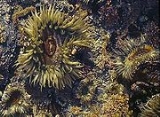
Aggregating anemone
Overview
Anthopleura elegantissima, also known as the aggregating anemone or clonal anemone, is the most abundant species
of sea anemone
found on rocky, tide swept shores along the Pacific coast of North America
. This cnidarian hosts endosymbiotic algae
called zooxanthellae that contribute substantially to primary productivity in the intertidal zone
. A. elegantissima has become a model organism for the study of temperate cnidarian-algal symbioses.
The polyps of Anthopleura elegantissima reach up to eight cm across the oral disk with approximately 100 tentacles in three or four rows around the margins of the oral disk.
Species
In biology, a species is one of the basic units of biological classification and a taxonomic rank. A species is often defined as a group of organisms capable of interbreeding and producing fertile offspring. While in many cases this definition is adequate, more precise or differing measures are...
of sea anemone
Sea anemone
Sea anemones are a group of water-dwelling, predatory animals of the order Actiniaria; they are named after the anemone, a terrestrial flower. Sea anemones are classified in the phylum Cnidaria, class Anthozoa, subclass Zoantharia. Anthozoa often have large polyps that allow for digestion of larger...
found on rocky, tide swept shores along the Pacific coast of North America
North America
North America is a continent wholly within the Northern Hemisphere and almost wholly within the Western Hemisphere. It is also considered a northern subcontinent of the Americas...
. This cnidarian hosts endosymbiotic algae
Algae
Algae are a large and diverse group of simple, typically autotrophic organisms, ranging from unicellular to multicellular forms, such as the giant kelps that grow to 65 meters in length. They are photosynthetic like plants, and "simple" because their tissues are not organized into the many...
called zooxanthellae that contribute substantially to primary productivity in the intertidal zone
Intertidal zone
The intertidal zone is the area that is above water at low tide and under water at high tide . This area can include many different types of habitats, with many types of animals like starfish, sea urchins, and some species of coral...
. A. elegantissima has become a model organism for the study of temperate cnidarian-algal symbioses.
The polyps of Anthopleura elegantissima reach up to eight cm across the oral disk with approximately 100 tentacles in three or four rows around the margins of the oral disk.

